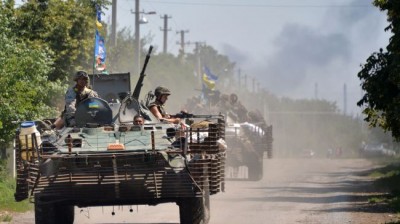Poland Announces Formation of Joint Military Unit with Ukraine and Lithuania

Polish President Bronislaw Komorowski announced on Friday the official formation of a joint military unit that will include Ukrainian and Lithuanian armed forces. Known as the Lithuania-Poland-Ukraine Brigade (LITPOLUKRBRIG), the new unit of approximately 4,500 soldiers will be based near the Ukrainian border in Lublin, Poland. The unit is scheduled to begin its first exercises sometime in the next year.
The formation of the LITPOLUKRBRIG was initially agreed to in late 2009, but the plans were scuttled after the election of Victor Yanukovych in Ukraine in February 2010. Yanukovych, who was more closely aligned with Russia, was ousted in a right-wing coup in February of this year after he refused to sign an association agreement with the European Union.
The formation of the unit was announced in the wake of Ukrainian President Petro Poroshenko’s bellicose speech before a joint session of the US Congress and the ratification of the Association Agreement by the European and Ukrainian parliaments.
After the deal was officially inked by the three countries’ defense ministers, Komorowski said that the tripartite unit was “part of a wider plan to support Ukraine, among others, in the area of modernization.”
A spokesman for the Polish Defense Ministry also told reporters that while the unit would initially function as a peacekeeping force, it could serve as the nucleus for the development of a NATO battle group at some point in the future.
The right-wing, pro-Western government that has been established in Ukraine, under the leadership of Poroshenko, has been pressing for closer military ties with the United States and other NATO member states in Eastern Europe.
Lithuania became a full member of NATO in 2004. Under Article Five of the NATO treaty, which stipulates that an attack on one member is an attack on all, the United States and all other NATO states are committed to defending the Baltic States, including Lithuania, if they come under attack.
This creates the conditions where, if the newly formed unit comes under attack as part of operations in Ukraine, it could be used to trigger an Article Five response from the US and other NATO countries in Western Europe against Russia.
Last month Lithuanian President Dalia Grybauskaite stated that as a result of its alleged intervention in Ukraine in support of the separatists, Russia was “in a state of war against Europe.”
Fighting in Ukraine between Kiev-backed forces and pro-Russian separatists in the east is being used to justify an increased militarization of NATO countries in Eastern Europe as well as a campaign of economic sanctions against Russia. The official formation of the new unit is just one part of this reckless campaign being carried out by the US, European Union and NATO which threatens the possibility of war with Russia.
At the NATO summit in Wales earlier this month, alliance members agreed on plans to create a new rapid response force of approximately 4,000 soldiers that would be stationed on a rotating basis in member states that border Russia. US President Barack Obama gave an inflammatory speech in Estonia on September 3 in which he pledged America’s “eternal assistance” to the Baltic States.
On Friday, NATO also began military exercises off the coast of Romania in the Black Sea. Canada’s HMCS Toronto and Spain’s ESPS Almirante Juan de Borbón will be participating in the NATO exercise and will be stationed in the port at Varna, Bulgaria until Monday.
The Rapid Trident military exercises led by the Ukrainian armed forces and involving the US and other NATO member states are also ongoing in western Ukraine and are scheduled to conclude on September 26.
While NATO is increasing its military activities in Eastern Europe, the Contact Group on the Crisis in Ukraine—composed of representatives of Ukraine, Russia, pro-Russian separatists and the Organization for Security and Cooperation in Europe (OSCE)—met again in Minsk, Belarus. The parties are working to implement a peace deal and maintain a fragile cease fire that was implemented on September 5.
Former Ukrainian President Leonid Kuchma, representing Kiev, said that he expected “some movement forward from this meeting.” Russia’s Ambassador to Ukraine, Mikhail Zurabov, stated that “some important decisions could be adopted, which could make previous agreements more viable.”
In addition to the Contact Group meeting in Minsk, three-way talks between Ukraine, Russia, and the EU aimed at resolving an ongoing gas pricing dispute are scheduled to begin next Friday. The Russian energy company Gazprom halted deliveries of natural gas to Ukraine in June after talks over Kiev’s debt to the company collapsed and the regime refused to agree to pay immediately for new gas deliveries.
Russian Energy Minister Alexander Novak told reporters that Ukraine would not have to pay its $5.3 billion gas debt all at once. He also made clear that Russia was prepared to lower the price of natural gas from $485 to $385 per 1,000 cubic meters.
While the situation in eastern Ukraine was relatively calmer on Friday, several weeks of intermittent artillery shelling in and around the city of Donetsk have threatened to break the ceasefire. The Donetsk City Council reported one civilian death, and the Ukrainian military reported that two of its soldiers had been killed.
Since the implementation of the ceasefire, dozens of civilians have been killed or wounded by indiscriminate artillery fire. According to the United Nations, at least 2,900 people have lost their lives since Kiev began its crackdown on pro-Russian separatists in April. The UN also estimates that as many as 1 million people have been displaced by fighting in the Donbass region.

